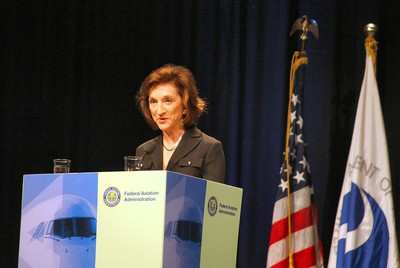It’s good to see a lot of familiar faces out there, and I
see some new ones as well. So let me welcome all of you back, those
of you who’ve been with us over the years. And if this is
your first time here, well, congratulations, you’re about to
become a part of history.
The FAA’s been holding the Forecast Conference for more
than three decades now, and I’m proud to announce that this
is our biggest crowd ever. Thanks for being here. If we’re
talking about what’s on aviation’s horizon, then it
must be that time of year.
 You know, you can always gauge what
month it is around here by three barometers: the Girl Scout
cookies, the March Madness brackets, and this gathering right
here.
You know, you can always gauge what
month it is around here by three barometers: the Girl Scout
cookies, the March Madness brackets, and this gathering right
here.
A little later on, we’ve got a dynamic luncheon speaker in
Glenn Tilton. I don’t know what he's going to say, but
Glenn's like one of those brokerage firm commercials from days gone
by — when he talks, people listen.
Fact is, people are sitting up and people are taking notice when
aviation's in the house. And you know that was exactly our mindset
when we came up with this year's theme.
If you didn't get the memo, aviation is back, ladies and
gentlemen, back in a big way. Dare I say that some of the carriers,
walking on wobbly legs for the last couple of years, are regaining
sure footing?
Now tell me, when's the last time anyone heard the words
"airline" and "profit" in the same sentence? Well I believe we can
get used to it.
On the GA side, billings and shipments are up as well.
Indeed, aviation is on a resurgence everywhere, from Main Street
to Wall Street. Over the last several months, three
aircraft-related companies have filed their IPOs and gone public.
One of the companies makes unmanned aircraft, another designs
airplane structures like fuselages and propulsion systems, and the
third leases airplanes.
If you look at what their stock prices are doing lately, you'll
see that all three companies are going in the same direction as the
rest of aviation — up.
Need more convincing that things aren't the same? Here's a
forecast from one of Wall Street's most influential firms: "We
think 2007 could be an even better year than 2006 for most
airlines. Industry fundamentals have not been this good in
years."
Now before we break out the champagne, let's down a little
coffee. I'm sure by now many of you are familiar with that memo
that made its way around the executive suite at Starbucks.
It was written by the CEO, the same guy who's convinced millions
of people that paying $4 to see someone make a cup of joe would be
worth the experience.
The boss says in the email that he's concerned that Starbucks is
losing its Midas touch, that walking into one of their stores is no
longer quote unquote "the experience" it once was.

Sound familiar? How many times have you heard about what flying
used to be like?
Remember when Starbucks made the decision awhile back to go to
automatic espresso machines? Well, it saved time and efficiency,
but at what cost?
Well, let me quote the CEO again: "This specific decision became
even more damaging when the height of the machines blocked the
visual sight line the customer previously had to watch the drink
being made, and for the intimate experience with the barista."
So, in the face of competition from McDonald's and Dunkin'
Donuts, what does the head of the world's biggest coffee chain
propose doing to regain that so-called customer experience?
Well, he writes: "Let's be smarter about how we are spending our
time, money and resources. Push for innovation."
I think that's exactly what we are doing in aviation on a
variety of fronts. One of the most important is moving to the
NextGen that we've been discussing at length this morning. And I
think that's exactly what we're seeking to accomplish with our
legislation.
We're completely re-thinking the way the system is financed,
because we know that the status quo won't get us to NextGen fast
enough.
Pegging our revenues to a ticket tax may have worked back in the
day, but it's not the way to go today. The time has come to push
for innovation, and that's what our bill does. It puts the focus
where it belongs, on the customer experience.
I think we'll all agree that the people whom we serve —
our customers — don't deserve to be mired in congestion,
circling and going nowhere.
 I'm talking here about
the guy in seat 22B. And I'm talking about the recreational pilot
who wants to take her family up for a quick spin around the
countryside.
I'm talking here about
the guy in seat 22B. And I'm talking about the recreational pilot
who wants to take her family up for a quick spin around the
countryside.
We need to focus on what's really important here, and not just
who picks up the tab.
If we don't get the stable financing we need, NextGen will be
the solution to a problem that we anticipated and studied but
failed to really address. And what's going to be the cost?
I'll tell you -- delays. Two thousand six was the worst ever on
record. There were 491,860 commercial flights that didn't takeoff
or land on time. That adds up to a lot of customers who didn't make
it home when they hoped they would. And I hate to say it, but 2007
isn't looking any better.
In terms of commercial operations, we've got 18 of our biggest
airports at their pre-9/11 highs. We're projecting that we'll add
four more to the list -- Baltimore, Detroit, Newark and Phoenix --
in just the next couple of years.
The looming spike in passengers that's in our Forecast report
will fuel a nationwide increase in takeoffs and landings by 2020.
In turn, some key hubs will see a significant ramp-up in their
operations.
Dulles is looking at a 68 percent increase. Out West, LAX may
rise by 54 percent. That's total operations -- commercial and GA --
I'm talking about here.
Airports. They're one of the pillars in our NextGen
endeavor.
In the last 40 years, we've added two -- DFW and Denver
International. We may need to add as many as four more in the next
20 or 30 years. They would be either replacement or supplemental
airports. The question is, where to put them?
We'll have a good idea soon. In the near future, the FAA will be
releasing a study on the communities that need more airport
capacity. It's called Capacity Needs in the National Airspace
System, or FACT report, for short.
Since the first FACT study hit the streets back in '04, five new
runways have opened for business. They include Hartsfield, Logan
and St. Louis. Six more runways are under construction.
What we've learned so far with the FACT report is that some
communities have made good progress, and we've taken them off our
watch list. Others have been added.
While the report is being finalized, I can tell you that we'll
continue to have capacity problems on both coasts. The congestion
is becoming more chronic, and we're going to have to re-think our
approach in those high-density areas.
Of course, the story's not just about congestion on the ground.
It's in the airspace too.
Take the Sunday after last Thanksgiving. The traffic was so
heavy, we used our Airspace Flow Program to make sure the airspace
didn't get overloaded. Now mind you, we normally use AFPs to deal
with thunderstorms, not congestion.
Even so, more than 2,000 flights were delayed. And that was on a
day when Mother Nature was in a good mood.
Imagine how bad it would have been if even a few parts of the
country got hit with a storm or two?

Even now, days with ordinary traffic levels don't have enough en
route capacity when thunderstorms hit. I hate to think what it's
going to be like with storm season right around the corner.
Looking out into the future, as I see it, the gridlock won't
happen all at once. It'll be gradual, sort of the way a lake
freezes. It won't happen in one shot. But eventually, the cold
works its way along, paralyzing parts of the lake until the whole
thing is iced over.
Without NextGen, some parts of the system will "freeze" first.
Soon, other areas will follow. The system will reach its absolute
breaking point, and our customers will be the ones who suffer.
It doesn't have to be like that. We need NextGen, and our reform
bill is a good way to make it happen. Thank you.
 ANN's Daily Aero-Term (04.26.24): DETRESFA (Distress Phrase)
ANN's Daily Aero-Term (04.26.24): DETRESFA (Distress Phrase) ANN's Daily Aero-Linx (04.26.24)
ANN's Daily Aero-Linx (04.26.24) Airborne 04.22.24: Rotor X Worsens, Airport Fees 4 FNB?, USMC Drone Pilot
Airborne 04.22.24: Rotor X Worsens, Airport Fees 4 FNB?, USMC Drone Pilot Airborne 04.24.24: INTEGRAL E, Elixir USA, M700 RVSM
Airborne 04.24.24: INTEGRAL E, Elixir USA, M700 RVSM Airborne-NextGen 04.23.24: UAVOS UVH 170, magni650 Engine, World eVTOL Directory
Airborne-NextGen 04.23.24: UAVOS UVH 170, magni650 Engine, World eVTOL Directory







